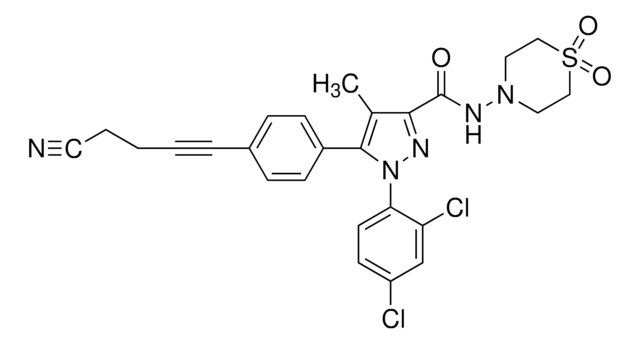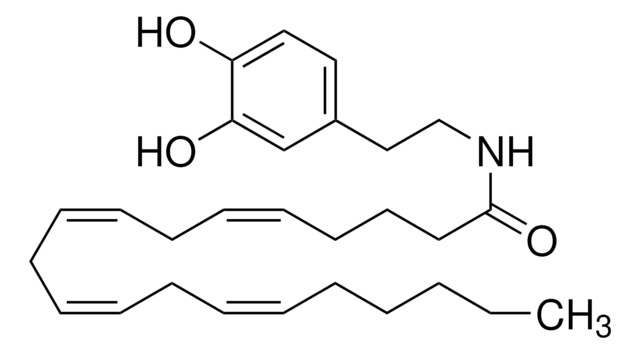A6226
AM251
>98% (HPLC), solid, cannabinoid receptor (CB1) antagonist
Sinônimo(s):
1-(2,4-Dichlorophenyl)-5-(4-iodophenyl)-4-methyl-N-1-piperidinyl-1H-pyrazole-3-carboxamide
About This Item
Produtos recomendados
product name
AM251, >98% (HPLC), solid
Nível de qualidade
Ensaio
>98% (HPLC)
forma
solid
cor
white
solubilidade
DMSO: >10 mg/mL
H2O: insoluble
originador
Sanofi Aventis
cadeia de caracteres SMILES
Cc1c(nn(-c2ccc(Cl)cc2Cl)c1-c3ccc(I)cc3)C(=O)NN4CCCCC4
InChI
1S/C22H21Cl2IN4O/c1-14-20(22(30)27-28-11-3-2-4-12-28)26-29(19-10-7-16(23)13-18(19)24)21(14)15-5-8-17(25)9-6-15/h5-10,13H,2-4,11-12H2,1H3,(H,27,30)
chave InChI
BUZAJRPLUGXRAB-UHFFFAOYSA-N
Informações sobre genes
mouse ... Cnr1(12801) , Cnr2(12802)
rat ... Cnr1(25248)
Aplicação
Ações bioquímicas/fisiológicas
Características e benefícios
Outras notas
Frases de perigo
Declarações de precaução
Classificações de perigo
Aquatic Chronic 4
Código de classe de armazenamento
11 - Combustible Solids
Classe de risco de água (WGK)
WGK 3
Ponto de fulgor (°F)
Not applicable
Ponto de fulgor (°C)
Not applicable
Equipamento de proteção individual
dust mask type N95 (US), Eyeshields, Gloves
Certificados de análise (COA)
Busque Certificados de análise (COA) digitando o Número do Lote do produto. Os números de lote e remessa podem ser encontrados no rótulo de um produto após a palavra “Lot” ou “Batch”.
Já possui este produto?
Encontre a documentação dos produtos que você adquiriu recentemente na biblioteca de documentos.
Os clientes também visualizaram
Nossa equipe de cientistas tem experiência em todas as áreas de pesquisa, incluindo Life Sciences, ciência de materiais, síntese química, cromatografia, química analítica e muitas outras.
Entre em contato com a assistência técnica









